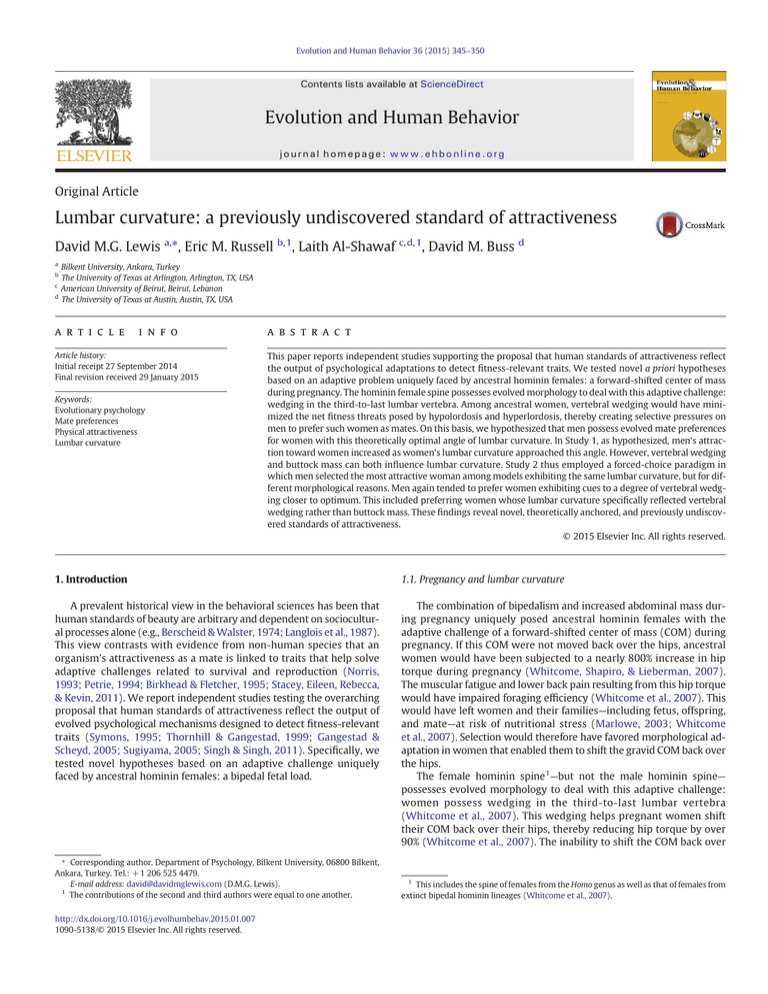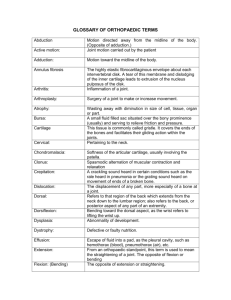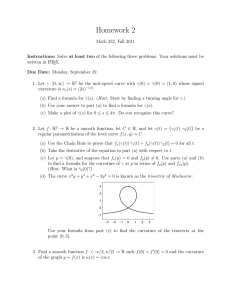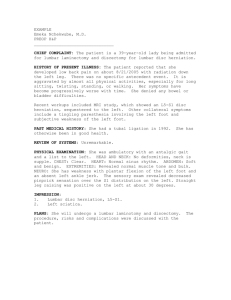
Evolution and Human Behavior 36 (2015) 345–350
Contents lists available at ScienceDirect
Evolution and Human Behavior
journal homepage: www.ehbonline.org
Original Article
Lumbar curvature: a previously undiscovered standard of attractiveness
David M.G. Lewis a,⁎, Eric M. Russell b,1, Laith Al-Shawaf c,d,1, David M. Buss d
a
Bilkent University, Ankara, Turkey
The University of Texas at Arlington, Arlington, TX, USA
c
American University of Beirut, Beirut, Lebanon
d
The University of Texas at Austin, Austin, TX, USA
b
a r t i c l e
i n f o
Article history:
Initial receipt 27 September 2014
Final revision received 29 January 2015
Keywords:
Evolutionary psychology
Mate preferences
Physical attractiveness
Lumbar curvature
a b s t r a c t
This paper reports independent studies supporting the proposal that human standards of attractiveness reflect
the output of psychological adaptations to detect fitness-relevant traits. We tested novel a priori hypotheses
based on an adaptive problem uniquely faced by ancestral hominin females: a forward-shifted center of mass
during pregnancy. The hominin female spine possesses evolved morphology to deal with this adaptive challenge:
wedging in the third-to-last lumbar vertebra. Among ancestral women, vertebral wedging would have minimized the net fitness threats posed by hypolordosis and hyperlordosis, thereby creating selective pressures on
men to prefer such women as mates. On this basis, we hypothesized that men possess evolved mate preferences
for women with this theoretically optimal angle of lumbar curvature. In Study 1, as hypothesized, men's attraction toward women increased as women's lumbar curvature approached this angle. However, vertebral wedging
and buttock mass can both influence lumbar curvature. Study 2 thus employed a forced-choice paradigm in
which men selected the most attractive woman among models exhibiting the same lumbar curvature, but for different morphological reasons. Men again tended to prefer women exhibiting cues to a degree of vertebral wedging closer to optimum. This included preferring women whose lumbar curvature specifically reflected vertebral
wedging rather than buttock mass. These findings reveal novel, theoretically anchored, and previously undiscovered standards of attractiveness.
© 2015 Elsevier Inc. All rights reserved.
1. Introduction
1.1. Pregnancy and lumbar curvature
A prevalent historical view in the behavioral sciences has been that
human standards of beauty are arbitrary and dependent on sociocultural processes alone (e.g., Berscheid & Walster, 1974; Langlois et al., 1987).
This view contrasts with evidence from non-human species that an
organism's attractiveness as a mate is linked to traits that help solve
adaptive challenges related to survival and reproduction (Norris,
1993; Petrie, 1994; Birkhead & Fletcher, 1995; Stacey, Eileen, Rebecca,
& Kevin, 2011). We report independent studies testing the overarching
proposal that human standards of attractiveness reflect the output of
evolved psychological mechanisms designed to detect fitness-relevant
traits (Symons, 1995; Thornhill & Gangestad, 1999; Gangestad &
Scheyd, 2005; Sugiyama, 2005; Singh & Singh, 2011). Specifically, we
tested novel hypotheses based on an adaptive challenge uniquely
faced by ancestral hominin females: a bipedal fetal load.
The combination of bipedalism and increased abdominal mass during pregnancy uniquely posed ancestral hominin females with the
adaptive challenge of a forward-shifted center of mass (COM) during
pregnancy. If this COM were not moved back over the hips, ancestral
women would have been subjected to a nearly 800% increase in hip
torque during pregnancy (Whitcome, Shapiro, & Lieberman, 2007).
The muscular fatigue and lower back pain resulting from this hip torque
would have impaired foraging efficiency (Whitcome et al., 2007). This
would have left women and their families—including fetus, offspring,
and mate—at risk of nutritional stress (Marlowe, 2003; Whitcome
et al., 2007). Selection would therefore have favored morphological adaptation in women that enabled them to shift the gravid COM back over
the hips.
The female hominin spine 1—but not the male hominin spine—
possesses evolved morphology to deal with this adaptive challenge:
women possess wedging in the third-to-last lumbar vertebra
(Whitcome et al., 2007). This wedging helps pregnant women shift
their COM back over their hips, thereby reducing hip torque by over
90% (Whitcome et al., 2007). The inability to shift the COM back over
⁎ Corresponding author. Department of Psychology, Bilkent University, 06800 Bilkent,
Ankara, Turkey. Tel.: +1 206 525 4479.
E-mail address: david@davidmglewis.com (D.M.G. Lewis).
1
The contributions of the second and third authors were equal to one another.
http://dx.doi.org/10.1016/j.evolhumbehav.2015.01.007
1090-5138/© 2015 Elsevier Inc. All rights reserved.
1
This includes the spine of females from the Homo genus as well as that of females from
extinct bipedal hominin lineages (Whitcome et al., 2007).
346
D.M.G. Lewis et al. / Evolution and Human Behavior 36 (2015) 345–350
We therefore advanced the hypothesis that men possess evolved
mate preferences for lumbar curvature in women. Because the theoretically optimal degree of vertebral wedging for women is one that minimizes the net fitness threats posed by hypolordosis and hyperlordosis,
we hypothesized that men should possess an evolved preference for
women with an angle of lumbar curvature maximally distant from
these countervailing threats, which orthopedic medical literature indicates is approximately 45.5° (see Fernand & Fox, 1985).
2. Study 1: lumbar curvature and attractiveness
Men rated the attractiveness of female models varying in lumbar
curvature. Unlike previous research, we used profile rather than frontal
images; the latter cannot capture important cues available only from alternative perspectives (Marlowe, Apicella, & Reed, 2005), such as lumbar curvature from the side. Consequently, the current studies are
(1) among the few to employ non-frontal views, and (2) the first to assess the influence of lumbar curvature on physical attractiveness.
2.1. Method
Fig. 1. A woman with (a) less vertebral wedging at the third-to-last lumbar vertebra (modal
L3 depicted), and (b) greater wedging, resulting in a more acute angle of lumbar curvature.
the hip joints, on the other hand, results in sustained contraction of the
lower back muscles, which increases risk of fatigue and injury (White &
Punjabi, 1990).
Indeed, insufficient lumbar curvature (hypolordosis) is associated
with lower back pain (Rath & Rath, 1997), but so is excessive lumbar
curvature (hyperlordosis; Christie, Kumar, & Warren, 1995; Magnora,
1975). These countervailing forces would have resulted in stabilizing selection on ancestral women's spines. Selection would have favored vertebrae in women that were (1) sufficiently wedged to center the gravid
COM back over the hips, but nonetheless (2) provided sufficient skeletal
reinforcement to prevent hyperlordosis, fatigue, and spinal injury
(White & Punjabi, 1990; Whitcome et al., 2007).
1.2. Women's lumbar curvature and male mating psychology
The fitness benefits experienced by ancestral women with a beneficial intermediate degree of lumbar wedging between hypolordosis and
hyperlordosis would have created the background selective conditions
for the evolution of a male mate preference for such women. Men
who preferred and selected these women as mates would have gained
several key fitness benefits, including having a mate who was less vulnerable to spinal injuries, better at foraging during pregnancy, and better able to sustain multiple pregnancies without debilitating injury. On
this basis, we advance the hypothesis that selection fashioned psychological adaptations in men to detect cues to lumbar vertebral wedging
in women and regulate mating attraction accordingly.
Ancestral men could not have directly observed potential mates'
vertebrae, so their detection of vertebral wedging had to be based on
observable cues. One cue to lumbar vertebral wedging is the curvature
of the lower back (George, Hicks, Nevitt, Cauley, & Vogt, 2003). Wedging
in the lumbar vertebrae extends the tailbone relative to the rest of the
spine, resulting in a more acute angle between the thoracic back and
buttocks (see Fig. 1).2
2
Consistent with this, the sex difference in vertebral wedging is associated with a sex
difference in external lumbar curvature (Fernand & Fox, 1985; women: mean = 47.19°,
men: mean = 43.25°, Cohen’s d = .35).
2.1.1. Participants
One hundred two men (Mage = 19.00 years, SDage = 2.41, age range:
17–34 years) were recruited from the psychology subject pool at The
University of Texas at Austin. Participants received course credit
for participation.
2.1.2. Photographic stimuli and attractive ratings
Fifteen images were generated in Adobe Photoshop by manipulating
the angle of lumbar curvature of female targets. For each target, we generated five morphs of varying angles of lumbar curvature (see Fig. 2).
These stimuli captured the naturally occurring range of lumbar curvature in the population (stimuli range: 14–69°; see Fernand & Fox,
1985). The targets' lumbar curvature was the sole variable that
we manipulated.
All morphs were presented in random order to participants, who
rated the attractiveness of each morph on a 10-point scale (1 = extremely unattractive, 10 = extremely attractive).
2.2. Results
2.2.1. Statistical analysis
Because each participant rated the attractiveness of multiple morphs
of each target, we tested the relationship between lumbar curvature
and attractiveness via hierarchical linear modeling (HLM). Attractiveness ratings were clustered by participant-target combination to control
for baseline differences in participants' perceptions of the targets' attractiveness. Controlling for between-target differences in attractiveness eliminated between-target influences on attractiveness (facial
appearance, clothing, etc.), thereby isolating the relationship between
lumbar curvature and attractiveness.
2.2.2. Lumbar curvature and attractiveness
To test the relationship between women's lumbar curvature and attractiveness, we fitted three different models: (1) a simple linear relationship, (2) a curvilinear relationship with an unspecified inflection
point, and (3) an inverse linear relationship between women's attractiveness and their lumbar deviation from the hypothesized optimum
of 45.5°. Model 1 differs from model 3 in that model 1 posits that increases in lumbar curvature above the hypothesized optimum are associated with further increases in attractiveness, whereas model 3
proposes that further increases above this angle are associated with decreased attractiveness as women's spines approach hyperlordosis. Although both model 2 and model 3 are consistent with an evolutionary
history of stabilizing selection, model 3 more directly reflects the idea
that men possess an evolved mate preference specifically for the angle
D.M.G. Lewis et al. / Evolution and Human Behavior 36 (2015) 345–350
347
Fig. 2. Schematic of a complete series of stimuli.
clinical definition of lumbar curvature (see George et al., 2003). We
therefore conducted a second study to discriminate between these
two alternatives: does men's preference for lumbar curvature reflect a
preference for cues to vertebral wedging, or can it be attributed to a
preference for buttock mass?
3. Study 2: a preference for cues to vertebral wedging or
buttock mass?
Fig. 3. The relationship between women's lumbar curvature and physical attractiveness.
Dots represent mean attractiveness ratings for each morph of each model. Lines indicate
model-predicted values.
of lumbar curvature maximally distant from the countervailing threats
of hypolordosis and hyperlordosis.3
Among these three models, model 3 best fits the relationship between
women's lumbar curvature and attractiveness (residual variances: model
1 = 1.80, model 2 = 1.62, model 3 = 1.59). Precisely as hypothesized,
women's attractiveness increased as their lumbar curvature approached
the proposed theoretically optimal angle, β = −.48, SE = .01, p b .0001
(see Fig. 3).
2.3. Discussion
These data support the hypothesis that men possess an evolved
mate preference for angles of lumbar curvature that facilitate the solution of the female-specific adaptive challenge of a bipedal fetal load. Precisely as hypothesized, women's attractiveness peaked at a theoretically
optimal angle maximally distant from the adaptive problems of insufficient and excessive lumbar curvature.
Establishing the importance of lumbar curvature does not demonstrate, however, that this preference is specifically for cues to vertebral
wedging. Both vertebral wedging and buttock mass can influence the external angle formed between the buttocks and thoracic spine—the
3
Implicit in this model is the assumption that the fitness costs of hypolordosis and
hyperlordosis are roughly equivalent. Although the exact probabilistic fitness costs may
not be strictly identical, this model represents a reasonable operationalization of the central hypothesis.
In Study 2, participants viewed photographic arrays depicting multiple morphs of individual female targets. Within each array, all morphs exhibited identical buttock protrusion, but this resulted from (a) vertebral
wedging in one morph, and (b) buttock mass in the others.
Participants selected the most attractive morph within each array.
This forced-choice procedure enabled a direct test of whether men's
preference for female lumbar curvature is driven by a preference for
cues to vertebral wedging or by a preference for buttock mass
(e.g., Brown & Konner, 1987).
3.1. Method
3.1.1. Participants
Two hundred two men (Mage = 18.80 years, SDage = 1.50, age
range: 17–33) were recruited from the psychology subject pool at The
University of Texas at Austin. Participants were granted course credit
for their participation.
3.1.2. Image arrays
Participants were presented with 12 photographic arrays, each of
which consisted of three morphs of a single female target. Within each
array, all three morphs exhibited identical protrusion of the buttocks,
but for different morphological reasons (see Fig. 4). The buttock protrusion of the first two morphs resulted from buttock mass. The first morph
exhibited a distribution of buttock mass associated with physical fitness.
The second morph exhibited a distribution of buttock mass associated
with deposition of adipose tissue around the hips, a cue to fertility in
women (de Ridder et al., 1990; Jasienska, Ziomkiewicz, Ellison, Lipson,
& Thune, 2004). The buttock protrusion of the third morph, however,
reflected lumbar vertebral wedging.
The physical fitness and vertebral wedging morphs within a given
array also exhibited an identical angle between the thoracic spine and
buttocks. That is, within a given array, these morphs exhibited the
same external lumbar curvature.
Controlling for these attributes among the morphs was a key feature
of study design. Because all three morphs within each array exhibited
348
D.M.G. Lewis et al. / Evolution and Human Behavior 36 (2015) 345–350
Fig. 4. Buttock protrusion associated with (a) gluteal development indicating physical fitness, (b) adipose tissue deposition, and (c) vertebral wedging. Notes: All women exhibit identical
buttock protrusion. Women (a) and (c) also exhibit an identical angle between the thoracic spine and buttocks (i.e., lumbar curvature).
the same protrusion of the buttocks, any differences in attractiveness
between morphs could not be attributable to buttock protrusion. Further, because the physical fitness and vertebral wedging morphs
within a given array possessed the exact same angle of external lumbar curvature, any differences in attractiveness between these
morphs could not be attributable to curvature angle per se, but rather
must be due to the underlying morphological cause (buttock mass
vs. vertebral wedging).
We generated and tested arrays at four different levels of buttock
protrusion (conditions 1–4). In all arrays in all conditions, the
morphs described above exhibited the exact same angle of external
lumbar curvature. In some conditions, this angle was below optimum; in condition 1, it was over 9° below optimum, and in condition
2 it was approximately 4.5° above optimum. Paralleling this structure, in condition 3 this angle was approximately 4.5° above optimum, and in condition 4 it was approximately 9° above optimum.
This enabled us to test the hypothesized preference for cues to vertebral wedging at angles of external lumbar curvature both above and
below the hypothesized optimum.
Our hypothesis that men have an evolved preference for cues to
an optimal, intermediate degree of vertebral wedging leads to the
following predictions. First, when women exhibit a degree of lumbar
curvature that is below the optimum, men should prefer the woman
for whom this angle results from vertebral wedging over a woman
for whom this angle reflects buttock mass—in this case, the vertebral
wedging morph possesses a degree of underlying wedging closer to
the optimum. Second, and in contrast, when women's lumbar curvature exceeds the optimum, this preference for the vertebral wedging
morph should disappear. When two women exhibit an angle of external lumbar curvature that exceeds the optimal value, the woman
with greater buttock mass—for whom this angle is associated with
less extreme vertebral wedging—is the one whose underlying vertebral wedging is closer to optimum. This hypothesis therefore yields
the prediction that men should prefer the vertebral wedging
morph at angles of lumbar curvature below the optimum, but not
above the optimum.
Because the buttock mass morphs had more mass around the hips,
in each array they possessed a lower WHR than the vertebral wedging
morph. For each array, participants were asked to select the most attractive of the three morphs.
3.2. Results
We conducted chi-square analyses on the forced-choice data to determine whether the Study 1 findings reflect (1) a theoretically predicted, novel male preference for cues to vertebral wedging, or (2) the first
systematic evidence for a male preference for buttock mass. Either
outcome would have been empirically informative, but our a priori reasoning pointed to the importance of vertebral wedging as a theoretically
anchored and previously undiscovered evolved attractiveness cue.
Overall, men preferred women whose buttock protrusion reflected
vertebral wedging, not buttock mass, χ 2(2, N = 202) = 265.84,
p b .0001 (see Fig. 5). Furthermore, direct comparison of the morphs
possessing identical angles between the thoracic spine and buttocks
(i.e., identical lumbar curvature) revealed that men preferred the
morphs for whom this angle was attributable specifically to vertebral
wedging, χ2(1, N = 202) = 172.22, p b .0001. These results unambiguously demonstrate that men distinguish between women whose external lumbar curvature reflects vertebral wedging and women whose
external lumbar curvature reflects buttock mass.
Fig. 5. Men's preference for cues to vertebral wedging versus buttock mass across different
levels of external lumbar curvature. The x-axis organizes the arrays of women according to
lumbar condition; in some conditions, the women's external lumbar curvature was below
optimum, in other conditions, it was above optimum. The tick marks on the x-axis indicate
the WHR of the women within the arrays.
D.M.G. Lewis et al. / Evolution and Human Behavior 36 (2015) 345–350
349
However, our theoretically anchored reasoning did not point toward
a simple main effect; rather, our hypothesis suggested that men's preference for cues to vertebral wedging should depend on women's degree
of external lumbar curvature. Consistent with these expectations, men's
preference for vertebral wedging varied as function of the women's
angle of external lumbar curvature [morph × condition interaction:
χ2(6, N = 202) = 182.82, p b .0001] (Fig. 5). When the photographic arrays depicted women with below-optimal levels of lumbar curvature
(conditions 1 and 2), men preferred women whose external lumbar
curvature reflected underlying vertebral wedging over women whose
(identical) external lumbar curvature reflected greater buttock mass
[condition 1: χ 2(1, N = 202) = 144.83, p b .0001; condition 2: χ 2(1,
N = 202) = 51.23, p b .0001]. However, in condition 3, in which the
morphs exhibited above-optimal levels of external lumbar curvature,
the preference for the vertebral wedging morph disappeared. At these
above-optimal levels of lumbar curvature, men preferred the morph
with greater buttock mass—the morph whose underlying vertebral
wedging was closer to the optimum, χ 2(1, N = 202) = 14.02,
p b .001. Unexpectedly, when women exhibited angles of lumbar curvature more drastically above the optimum, the data showed a return
to the pattern we observed at below-optimal levels [condition 4:
χ 2 (1, N = 202) = 105.66, p b .0001]. We discuss this unpredicted
finding below.
women whose curvature reflected greater buttock mass. In all conditions but one, men preferred the women whose lumbar curvature was
closer to optimum. This included (1) preferring women exhibiting
cues to greater underlying vertebral curvature in conditions in which
the women exhibited below-optimal levels of curvature, and (2) preferring cues to less underlying vertebral wedging in condition 3, when the
women exhibited above-optimal levels of curvature. Moreover, the fact
that men's preference for cues to greater vertebral wedging prevailed in
both of the below-optimal conditions—despite the WHR advantage of
the women with greater buttock mass —is a striking indicator of the robustness of this preference.
3.3. Discussion
Our hypothesis about men's preference for “intermediate” lumbar
curvature was driven by a priori reasoning, anchored in the adaptive
problems posed to ancestral women by hypolordosis and hyperlordosis.
The countervailing fitness threats of insufficient and excessive lumbar
curvature would have created stabilizing selection on women's spines
favoring an intermediate optimum between hypolordosis and
hyperlordosis. Accordingly, we operationalized this theoretically optimal angle by reference to values identified in the orthopedic medical literature as posing these fitness-relevant threats.
Reproductive-aged women's mean angle of lumbar curvature may
approximate this theoretically optimal angle of lumbar curvature, but
framing men's preference merely as one for “average” values is only
partially accurate4 and, more importantly, it misses the central evolutionary reason for the preference.
Humans' distant ancestors did not have the vertebral wedging present in the modern female spine; the average among our primate ancestors was distinctly non-wedged (Whitcome et al., 2007). This is because,
prior to bipedalism, selection would have penalized lumbar vertebral
wedging; its biomechanical costs would not have been outweighed by
fetal load-offsetting benefits.
The transition to bipedalism introduced novel selective pressures
that favored (a) female lumbar vertebral wedging and (b) male mate
preferences for women exhibiting cues to such wedging. Precisely because of this dual (natural and sexual) selective advantage of vertebral
wedging over the ancestral average, the new, wedged optimum gradually would have come to characterize the center of reproductive-aged
women's distribution. Portraying men's preference as one for “average”
values thus misses the central evolutionary reason underlying
the preference.
Determining the nuances of the evolutionary history that led to
modern humans' lumbar curvature awaits future research. At present,
the results from these studies support the hypothesis that men possess
theoretically anchored and previously undiscovered mate preferences
for lumbar curvature, and that this reflects a preference for vertebral
wedging, not buttock mass. Lumbar curvature thus represents an
These results show that men's preference for lumbar curvature is
unequivocally not a by-product of a preference for buttock mass. Men
(1) discriminate between women whose external lumbar curvature reflects vertebral wedging and those whose (identical) curvature reflects
buttock mass, (2) prefer women with greater vertebral wedging over
women with greater buttock mass at sub-optimal levels of lumbar
curvature—when the former's underlying spinal structures are closer
to the optimum, and (3) exhibit the expected reversal of this preference
at certain angles of lumbar curvature above optimum.
Along with these theoretically expected findings came an unexpected observation: men appear to prefer women with greater vertebral
wedging at angles of lumbar curvature drastically above the optimum.
We interpret this finding as an anti-preference, and we think at least
two distinct causes may be responsible for this phenomenon. In condition 4, the buttock mass morphs possessed less extreme vertebral
wedging than the wedging morphs, but the relative benefits of this
slightly reduced vertebral wedging may not offset the costs of the buttock mass morphs' excessively low WHR and extreme degree of buttock
mass. That is, the buttock-mass morphs in condition 4 may have exhibited cues to the adaptive problems of both (1) excessive lumbar curvature and (2) excess lower body mass and a below-optimal WHR.
This second cluster of adaptive problems is associated with multiple
fitness-related costs. Extreme accumulation of adipose tissue puts individuals at risk for obesity-related fitness costs (Friedman, 2009), and a
WHR below 0.7 is associated with increased likelihood of hip fracture
(Faulkner et al., 1993; Frisoli et al., 2005). In light of previous research
showing that men are less attracted to women with WHRs below 0.7
(e.g., Marlowe & Wetsman, 2001; Streeter & McBurney, 2003), and
our Study 1 finding that men are less attracted to women with angles
of lumbar curvature that deviate from optimum, it may not be plausible
to interpret the disappearance of men's preference for the buttock mass
morphs in condition 4 as reflecting a male preference for angles of lumbar curvature well above optimal values. Rather, we suggest that men's
shunning of the buttock mass morphs in condition 4 likely reflects an
anti-preference for women exhibiting cues to both above-optimum
lumbar curvature and a sub-optimal WHR.
For now, it appears reasonable to conclude that men's preference for
lumbar curvature is not a by-product of a preference for greater buttock
mass. Across all four conditions, men discriminated between women
whose lumbar curvature reflected greater vertebral wedging and
4. General discussion
The convergent results from these independent studies reveal a
strong fit between observed standards of attractiveness and a priori predictions based on selective pressures operating during hominin evolution. These tests suggest that selection fashioned not only spinal
structures in women for solving pregnancy-related challenges, but
also attendant psychological adaptations in men for assessing female
physical attractiveness on the basis of these structures.
4.1. A preference for “averageness”?
4
The mean of reproductively viable women—but not all women—approximates the theoretical optimum. Pre-pubertal individuals exhibit angles of lumbar curvature more than 10°
below optimum (Shefi, Soudack, Konen, & Been, 2013). If men’s preference were based on an
average prototype constructed during ontogeny, then the reduced angles to which they are
exposed in their developmental cohort should contribute to the construction of this “average” and result in a preference that deviates from (1) the theoretical optimum, (2) the mean
of reproductive-aged women, and (3) that observed in the current study.
350
D.M.G. Lewis et al. / Evolution and Human Behavior 36 (2015) 345–350
important, but previously undiscovered component of physical attractiveness that fits seamlessly within a broader evolutionary logic for
standards of attractiveness (Sugiyama, 2005). Collectively, these findings underscore the value of an evolutionary psychological framework
for understanding human standards of attractiveness.
References
Berscheid, E., & Walster, E. (1974). Physical attractiveness. In L. Berkowitz (Ed.), Advances
in experimental social psychology (pp. 157–215). New York, NY: Academic Press.
Birkhead, T. R., & Fletcher, F. (1995). Male phenotype and ejaculate quality in the zebra
finch Taeniopygia guttata. Proceedings of the Royal Society B, 262, 329–334, http://dx.
doi.org/10.1098/rspb.1995.0213.
Brown, P. J., & Konner, M. (1987). An anthropological perspective on obesity. Annals of the
New York Academy of Sciences, 499, 29–46, http://dx.doi.org/10.1111/j.1749-6632.
1987.tb36195.x.
Christie, H. J., Kumar, S., & Warren, S. A. (1995). Postural aberrations in low back pain.
Archives of Physical Medicine and Rehabilitation, 75, 218–224 (Retrieved from http://
www.ncbi.nlm.nih.gov/pubmed/7717811).
de Ridder, C. M., Bruning, P. F., Zonderland, M. L., Thijssen, J. H., Bonfrer, J. M.,
Blankenstein, M. A., et al. (1990). Body fat mass, body fat distribution, and plasma
hormones in early puberty in females. Journal of Clinical Endocrinology &
Metabolism, 70, 888–893.
Faulkner, K. G., Cummings, S. R., Black, D., Palermo, L., Glüer, C. -C., & Genant, H. K. (1993).
Simple measurement of femoral geometry predicts hip fracture: The study of osteoporotic fractures. Journal of Bone and Mineral Research, 8(10), 1211–1217.
Fernand, R., & Fox, D. E. (1985). Evaluation of lumbar lordosis: A prospective and retrospective study. Spine, 10, 799–803, http://dx.doi.org/10.1097/00007632-198511000-00003.
Friedman, J. M. (2009). Obesity: Causes and control of excess body fat. Nature, 459,
340–342, http://dx.doi.org/10.1038/459340a.
Frisoli, A., Jr., Paula, A. P., Pinheiro, M., Szejnfeld, V. L., Piovezan, R. D., Takata, E., et al. (2005).
Hip axis length as an independent risk factor for hip fracture independently of femural
bone mineral density in Caucasian elderly Brazilian women. Bone, 37, 871–875.
Gangestad, S. W., & Scheyd, G. J. (2005). The evolution of human physical attractiveness.
Annual Review of Anthropology, 34, 523–548, http://dx.doi.org/10.1146/annurev.
anthro.33.070203.143733.
George, S. Z., Hicks, G. E., Nevitt, M. A., Cauley, J. A., & Vogt, M. T. (2003). The relationship
between lumbar lordosis and radiologic variables and lumbar lordosis and clinical
variables in elderly, African-American women. Journal of Spinal Disorders and
Techniques, 16, 200–206 (Retrieved from http://www.ncbi.nlm.nih.gov/pubmed/
12679677).
Jasienska, G., Ziomkiewicz, A., Ellison, P. T., Lipson, S. F., & Thune, I. (2004). Large breasts
and narrow waists indicate high reproductive potential in women. Proceedings of the
Royal Society B, 271, 1213–1217, http://dx.doi.org/10.1098/rspb.2004.2712.
Langlois, J. H., Roggman, L. A., Casey, R. J., Ritter, J. M., Rieser-Danner, L. A., & Jenkins, V. Y.
(1987). Infant preferences for attractive faces: Rudiments of a stereotype.
Developmental Psychology, 23, 363–369, http://dx.doi.org/10.1037/0012-1649.23.3.
363.
Magnora, A. (1975). Investigation of the relation between low back pain and occupation.
VII. Neurologic and Orthopedic Condition. Scandinavian Journal of Rehabilitation and
Medicine, 7, 146–151 (Retrieved from http://www.ncbi.nlm.nih.gov/pubmed/
130674).
Marlowe, F. W. (2003). A critical period for provisioning by Hadza men: Implications for
pair bonding. Evolution and Human Behavior, 24, 217–229, http://dx.doi.org/10.1016/
S1090-5138(03)00014-X.
Marlowe, F. W., Apicella, C., & Reed, D. (2005). Men's preference for women's profile
waist-to-hip ratio in two societies. Evolution and Human Behavior, 26, 458–468,
http://dx.doi.org/10.1016/j.evolhumbehav.2005.07.005.
Marlowe, F. W., & Wetsman, A. (2001). Preferred waist-to-hip ratio and ecology.
Personality and Individual Differences, 30, 481–489.
Norris, K. (1993). Heritable variation in a plumage indicator of viability in male great tits
Parus major. Nature, 362, 537–539, http://dx.doi.org/10.1038/362537a0.
Petrie, M. (1994). Improved growth and survival of offspring of peacocks with more elaborate trains. Nature, 371, 598–599, http://dx.doi.org/10.1038/371598a0.
Rath, J. D., & Rath, W. (1997). Mechanical low back pain in pregnancy—Preliminary findings in a consecutive cases series investigation. Philadelphia, PA: Fifth International
McKenzie Conference (Retrieved from http://duffyrath.com/pdf/Mechanical%20Low%
20Back%20Pain%20in%20Pregnancy.pdf).
Shefi, S., Soudack, M., Konen, E., & Been, E. (2013). Development of the lumbar lordotic
curvature in children from age 2 to 20 years. Spine, 38(10), 602–608.
Singh, D., & Singh, D. (2011). Shape and significance of feminine beauty: An evolutionary
perspective. Sex Roles, 64, 723–731, http://dx.doi.org/10.1007/s11199-011-9938-z.
Stacey, L. W., Eileen, A. K., Rebecca, J. S., & Kevin, J. M. (2011). Pterin-based ornamental
coloration predicts yolk antioxidant level in female striped plateau lizards
(Sceloporus virgatus). Journal of Animal Ecology, 80, 519–527, http://dx.doi.org/10.
1111/j.1365-2656.2010.01801.x.
Streeter, S. A., & McBurney, D. H. (2003). Waist-hip ratio and attractiveness: New evidence and a critique of “a critical test”. Evolution and Human Behavior, 24, 88–98.
Sugiyama, L. S. (2005). Physical attractiveness in adaptationist perspective. In D. M.
Buss (Ed.), The handbook of evolutionary psychology (pp. 292–343). New York,
NY: Wiley.
Symons, D. (1995). Beauty is in the adaptations of the beholder: The evolutionary psychology of human female sexual attractiveness. In P. R. Abramson, & S. D. Pinkerton (Eds.),
Sexual nature, sexual culture (pp. 80–118). Chicago, IL: University of Chicago Press.
Thornhill, R., & Gangestad, S. W. (1999). Facial attractiveness. Trends in Cognitive Science,
3, 452–460.
Whitcome, K. K., Shapiro, L. J., & Lieberman, D. E. (2007). Fetal load and the evolution of
lumbar lordosis in bipedal hominins. Nature, 450, 1075–1078, http://dx.doi.org/10.
1038/nature06342.
White, A. A., & Punjabi, M. M. (1990). Clinical Biomechanics of the Spine. Philadelphia,
PA: Lippincott.




